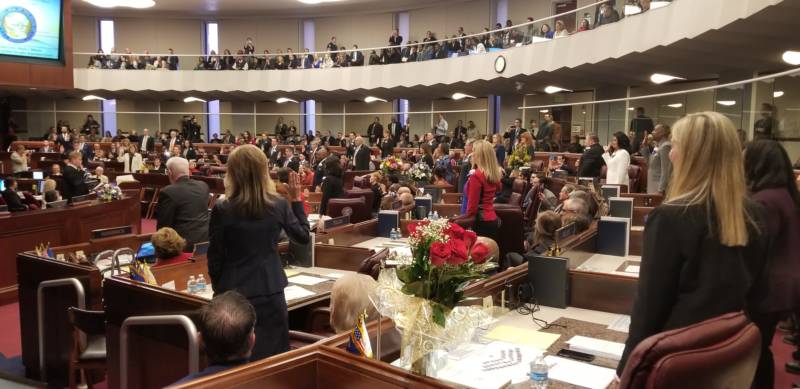Well, the answer might be because Californians are moving east.
"We have clearly seen waves of Californians move to Nevada over the years," said Fred Lokken, a political scientist at Truckee Meadows Community College in Reno. He says the influx of Californians to Clark and Washoe counties in Nevada has pushed the state into the blue. Previous waves of people moving from California to Nevada were made up mostly of disgruntled Republican business owners, he said, "and so that benefited the Republican Party."
This time around it's different. "What we’ve seen now, I would say in the last 24 to 36 months, are folks coming from both Southern and Northern California that are drawn to the economy of Nevada ... and many of those tend to be Democrats this time," Lokken said.
Nevada was not the only state with substantial gains by women in the Legislature last year. According to data collected by Sinzdak’s organization, women now account for roughly 28.5 percent of the total number of lawmakers in state legislatures nationwide – up more than 4 percent since 2016. In Western states, that rate is even higher – closer to 34.5 percent.
But there are outliers, including California, which has just 36 women in its 120-member Legislature. What's happening, said Sinzdak, is California has been outpaced by other states that are growing their female representation faster.
The only other western states with lower female representation are those dominated by Republicans — Utah, Idaho, and Wyoming. That’s because the GOP has struggled in recent years to recruit women to run for office.
"That’s certainly nothing new," Sinzdak said. "It’s just the degree to which that gap’s widened is pretty dramatic. What the Republican Party also needs to grapple with is: What are they doing or not doing to encourage newcomers to their party, and particularly women and other minority groups?"
Case in point: the Nevada Senate.
This year there are nine women in the 21-member Nevada Senate. That’s a net gain of one over the 2017 session. However, in that same amount of time, the number of Republican women has dropped from two to just one – state Sen. Heidi Gansert of Reno.
"What I know is that women are very independent and they’re entrepreneurial and they have a lot of leadership skills,” Gansert said. “So, I think that it will trend, for both parties, more and more female.”
But on the other side of the aisle, women are already in charge. This session, women will chair 13 of the Legislature’s 20 standing committees – including all of the relatively powerful finance committees.
"What I look at this session is what are we going to be able to accomplish; it’s not just about what one person can accomplish,” said floor majority leader, Assemblywoman Teresa Benitez-Thompson. "It’s not even about a title, or having a title, it’s really about what’s going to come from systemic change, political change, then legislative change. I’m thinking more about the big changes that are going to come than our influence as a group."
In California, that may just take a little longer.

